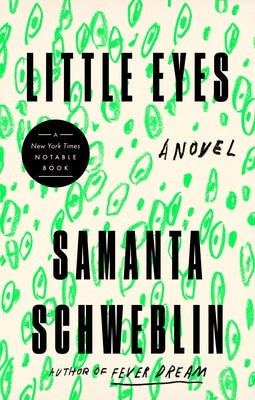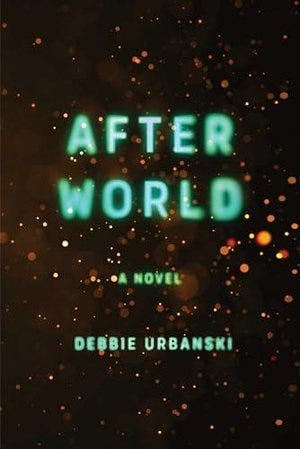
Happy 2025, dear readers!
The weather has been particularly dreary and gray of late, and perhaps this has subconsciously informed my reading habits, as the three novels I have to share with you today lean toward exploring the heavier aspects of human experience—death, grief, loss, etc.—as characters try (and often fail) to connect with others. While this is not everyone’s reading cup of tea, I often find a lot of counterintuitive solace in such stories. These three each moved me quite a bit, and in addition to their insight into the human condition, these books are also worth reading for their unique narrative structures. I hope you’ll find at least one to add to your TBR stack for the new year. :)
Little Eyes by Samanta Schweblin, trans. by Megan McDowell (Kentukis in the original Spanish)
“It had been explained to him that the kentuki was ‘someone,’ so he always spoke to it very politely. If it rolled between his legs, Enzo protested, but it was only a game—they were started to get along. Things hadn’t always been like that, though; at first, they’d had trouble getting used to each other, and the kentuki’s mere presence had been enough to make Enzo uncomfortable.”
After lightly perusing the rather mixed reviews on the Goodreads page for this book, I was fully expecting to set it aside after a chapter or two. People were complaining its disjointed chapters and lack of a central narrative arc, as well as its ultimately pessimistic view of human nature. It did not sound promising, yet two writers I respect had just recently recommended this writer to me so I decided to give it a try. I found that I could not put the book down. Yes, it’s disjointed. Yes, it’s dark. But it’s one of the most thought-provoking and absorbing novels I’ve read in the last year, investigating the reasons so many of us willingly relinquish our privacy and seek other lives in the digital realm.
The chapters are scattered all over the world—South Bend, Oaxaca, Zagreb, Barcelona, Lima, Beijing, to name a few—and some revisit the same locations and characters while others are essentially one-offs whose connections to the other stories are left unknown. The premise of the book involves how people engage with a near future technology in the form of a Furby-like robot called a kentuki. People are either “keepers” or “dwellers.” Keepers purchase the robot and seek out a randomly assigned connection with an unknown, anonymous second person who “inhabits” the kentuki by following its feed on a tablet and engaging in interactions limited by the kentuki’s capacity. The novel is interested in why and how people would engage with such a technology and what it might expose in human nature. Some of the characters are keepers, others dwellers; one is both. Significantly, each kentuki can make only one connection. Once this connection is severed by either party, the kenuki is effectively dead. In Little Eyes, these severances often come in startling circumstances.
Schweblin is a masterful storyteller with a light touch, never giving more or less than needed, and it’s astounding that she is able to build the world in which this technology exists such that readers have such strong emotional reactions to it—both positive and negative. As I continue to digest the book, I’m struck by the ways that reading literature resembles dwelling in a kentuki, albeit with more limited powers, and reading Little Eyes in particular is like dwelling in and keeping many kentukis.
After World by Debbie Urbanski
“Her death, at 22 years, 7 months, and 20 days of age, would not have come as some big surprise to anyone, including her. ‘The writing was on the wall, as people used to say, back when there were people. By the time she is splayed across that cabin floor, prostrate, unconscious, about to breathe her last labored breath, she has already experienced this moment, through Game No. u7 In Reverse, 763 times. This number likely would have been higher had she not stripped the wires from her hood, destroying the game’s brain-computer interface and preventing further play. The word game will remain problematic: a more accurate term would be simulation based on a multitude of inputs.”
Start with an AI-focused premise that would be at home in a Ted Chiang story collection, add a rather unexpected dash of Jon Krakauer’s Into the Wild and set it roughly in the context of a version of The World Without Us, and then nest this story in a wildly experimental and fragmented narrative frame that actively writes against literary depictions of the apocalypse that resolve in human triumph. Instead, envision a much bleaker but still optimistic end to the human experiment, and reckon with the accompanying mix of grief and longing and loss, the resultant mix of beauty and profound devastation. Here, you are beginning to have a sense of what you’re getting yourself into with Debbie Urbanski’s ambitious and haunting debut novel.
I don’t want to give too much away with this one because part of the joy of reading After World is in piecing together the puzzle of its multiple narrators’ identities and point of telling. I similarly recommend avoiding the jacket copy; I think this book is best read if you imagine yourself as perhaps an alien life form stumbling upon the records of the novel, absent any context as if they were the Voyager Golden Record abruptly fallen through the atmosphere of one’s planet. Like Little Eyes, the combination of a nontraditional structure with a rather dark subject matter will be too strong a flavor for some readers, but if you want to read a book that subverts apocalypse literature clichés and stretches your ideas of what’s possible in a novel, you will find this one very much worthwhile. Urbanski’s approach is rigorous and deeply considered. As much as it’s a book about grief and longing and an exploration of a (nearly) post-human vision of our present world as possibly the only real solution to the climate change, it’s also a book about storytelling, about how we record and understand ourselves, and what it means to love.
They Came Like Swallows by William Maxwell
“The curtain slipped back into place. Once more he could see nothing but reflections of the room. The night outside (and all that was in it) was shut away from him like those marvelous circus animals in wagons from which the sides had not been removed.”
If near-future technologies and AI elements do not appeal, this 1937 novel by William Maxwell, set during the 1918-1919 influenza pandemic, might be a perfect alternative. I was delighted to find this hardback first edition for the wildly reasonable price of $12.95 at Powell’s bookstore. The antique bookmark was a bonus I discovered later while reading the book, tucked between pages 62 and 63. I’m slightly baffled by its poor grammar, claims of 24 hour service, and reference to itself as a “blother” that fits in one’s check book, but I was pleased to find it just the same.
This is Maxwell’s second book, and the second of his I’ve read. (I covered his more well-known 1979 novella So Long, See You Tomorrow in Feb. 2024.) This novel is told in three parts, from the perspective of three members of a small Midwestern family, just as the pandemic begins to reach their small Illinois town in November 1918. It’s fascinating to read this novel against my own experiences during the first months of the COVID-19 pandemic and the way that time and information move both more slowly and more quickly than one might expect. The strength of the book is in its character building, and the slow revelation of what each of the three narrators understands or fails to understand about the others during a period of time when their family is changed forever. It’s not nearly as experimental on its face as the other two novels above, but Maxwell’s choice to move through three perspectives and never return to the first is an unexpectedly powerful way to tell this story.
I also appreciated the sense of time travel that comes with reading an older book. Though Maxwell is writing nearly twenty years after the influenza pandemic, he’s nevertheless writing for an audience likely to have firsthand knowledge of the time and place, so there is no explaining here. Occasionally, I encountered archaic words and phrases for which I have no point of reference (“automobile robes spread out on the ground”?), while in other cases, I was startled by the casual presence of technologies that I had assumed wouldn’t have been as common until decades later (like flashlights). In general, there are not many firsthand literary accounts of the influenza pandemic, at least in the U.S., and this is one that should be read more widely, especially for the realistic way it contextualizes the tragedy amidst the mundane drama’s of an ordinary family’s life.
Happy New Year, and as always, happy reading (even when the books are on the darker side of winter)!
Warmly,
Jules






